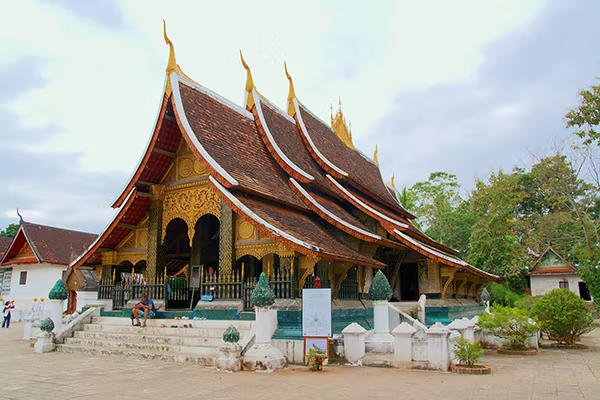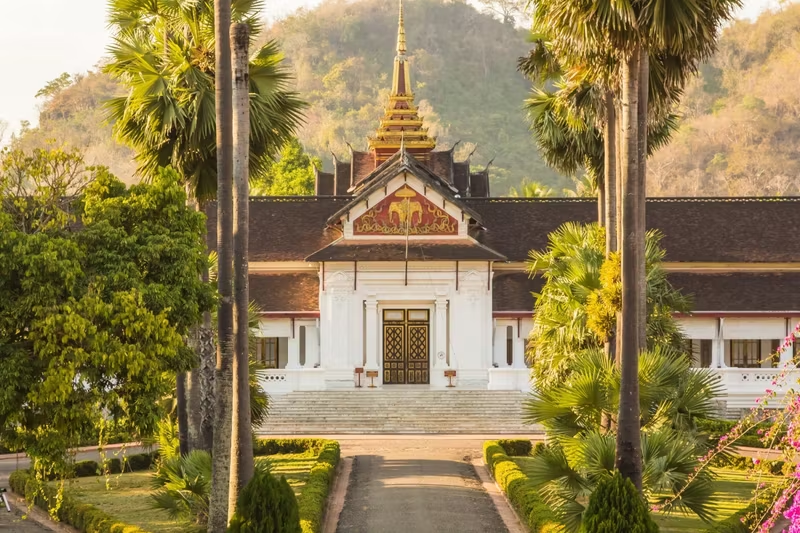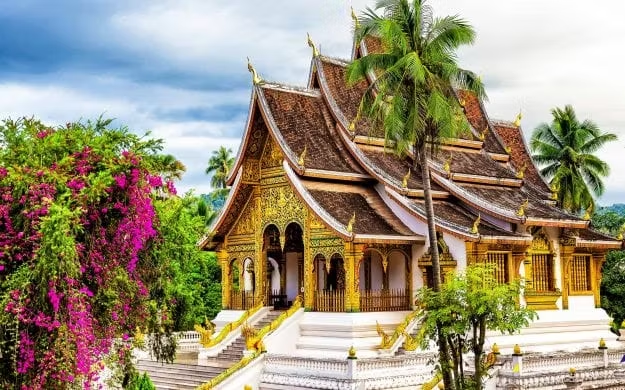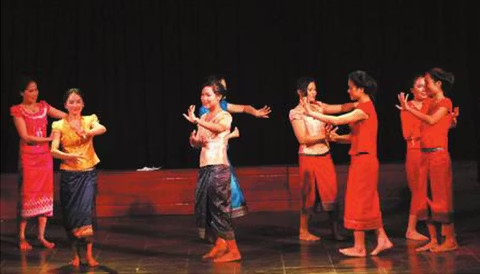Half Day LuangPrabang City Tour
Discover why LuangPrabang became a world heritage site and considered one of the most fascinating places in Asia. There is a tour to visit various temples and the royal palace in LuangPrabang. Hear many from local guide and learn about LuangPrabang, from its history to Buddhist stories and legends.
Itinerary
This itinerary can be customized to meet your needs and preferences. Send me a message with your requests!
Meeting Point
From your Hotel or Guesthouse
- This itinerary can be customized to meet your needs and preferences. Send me a message with your requests!
National museum / A former Loyal Palace
The Royal Palace Museum in Luang Prabang (also known as “Haw Kham” or "Golden Hall") was once Laos’ Royal Palace. It houses a lot of interesting historical items. Every item tells a story...so you will learn quite a lot about Lao history and about Laos’ royal.
Built in 1904, it features a blend of Lao traditional and French style. It was built for King Sisavang Vong and his family during the French colonial era.
After the death of King Sisavang Vong, the crown Prince Savang Vatthana and his family were the last to occupy the palace. After the revolution in 1975, the building was taken over by the government. The palace was then converted into a national museum and opened to the public in 1995.
Wat Mai temple
The Wat Mai Suwannaphumaham or Wat Mai (New Monastery) is one of the biggest and most beautiful temples in Luang Prabang. Its central position (in front of the night market and beside the Royal Palace) makes it one of the most visited temples of this ancient royal town.
Built late 18th century, 1821, and onward
The Wat Mai Suwannaphumaham or Wat Mai (New Monastery) is one of the biggest and most beautiful temples in Luang Prabang. Its central position (in front of the night market and beside the Royal Palace) makes it one of the most visited temples of this ancient royal town.
This Wat was built by King Anourout at the end of the XVIIIth century and was enlarged in the XIXth century. Its restoration, during the reign of King Manthatourat (1817-1836) gave it it’s final name of "New Monastery".
This temple is very important for the Laotians of Luang Prabang. After the Chinese had destroyed the town in the last half of the XIXth century, it served as a temple for the royal family, and also sheltered for a long time the Phra Bang, which is a mystical emblem in this country. It was also, the residence of the highest Lao Buddhist dignitary, Pra Sangkharat.
During Pimay, the Lao New Year, the Pha Bang is put on display in this temple for 3 days. Devout Laotians from all over the country come to devoutly sprinkle the statue with water whilst making wishes.
Wat Xienthong
Also known as the ‘Golden Tree Monastery’, Wat Xieng Thong acts as a gateway to Luang Prabang as it is strategically situated close to where the Mekong joins the Nam Khan River. This site is famous as the location for the coronation of Lao kings and as an important gathering place for significant annual festivities.
The original temple was created in 1560 under the royal instruction of King Setthathirath and narrowly missed invasion on several occasions, nevertheless, time took hold and much-needed remodelling took place during the 1960s. The temple still remains in its original form with repairs undertaken to the roof, and gold leaf gilding and gold lacquering restoration added to the walls and entrance.
Visoun Temple
Wat Wisunarat dates back to 1513 and named after King Wisunarat (Visoun), who ruled Laos from 1501 until 1520. It's the oldest Buddhist temple in Luang Prabang and served as the city's Museum of Religious Arts. You can see religious artifacts and precious items related to Buddhism and the royal family.
Another important and prominent feature of the wat is its unique That Pathoum, or Stupa of the Great Lotus, in the front and northeastern side of the sim. It is known more popularly as That Makmo, the "Watermelon Stupaï" because of its rounded dome. The dome stylistically reflects a Sinhalese influence and is the only stupa of such a shape in Laos, and perhaps even in Cambodia or Vietnam. Originally erected between 1514 and 1515, it was destroyed during the Haw Black Flag incursion in 1887. Inside were numerous ancient Buddha images. Many were destroyed; a number are in the National Palace Museum, and some are in the sim itself. Its reconstruction was not seriously undertaken until the late 1920s, over thirty years after the reconstruction of the sim, and was completed in 1932. The stupa sets on a number of different square tiers and has a Lao-Buddhist style Unisa crown at its top.
Phousii Hill
Sacred Mount Phousi
From the summit, you can enjoy a spectacular 360-degree outlook across the city and its many temples, and out over the surrounding landscape to the mountains in the distance. Count on spending a couple of hours for the climb and descent, with several stops to see the temples, rest under the shady trees and admire the magical views.
There are hundreds of steps to negotiate, but the climb is gentle enough for anyone who is in reasonable health. For a complete experience, go up Mount Phousi on one side and use the other set of steps to make your way down again. You can pray and make offerings at several temples along the way. Next to Wat Chomsi at the top of the hill, you can buy flowers to offer for blessings, as well as caged birds. Laos believes that if you set a bird free you will enjoy good luck and happiness in the future.
During peak tourist seasons, many tourists await on top of the Stupa the sunset and it does get very busy and crowded. DiscoverLaos Team would recommend that you visit in the morning for a relaxing journey and chance to snap a beautiful photo instead.
Ending Point
Phousii Hill
Want to personalize this tour?

This tour can be customized to meet your needs and preferences. Click below to send me a message with your requests.
Inclusions & Exclusions
Guide fee
Transfer
Tour permit document
All Entrance fee
Lunch
Drinks/water
Personal expenses
Other services not listed inclusive column
Tips and Gratitude
Tour Important Information
>This tour involves a lot of walking, so make sure to wear comfortable shoes and easy to remove in every entrances.
>A gentle reminder to cover your knees and shoulder with proper attire before entering the museum or rent their traditional attire. Otherwise you will be denied entry,
Important message from the supplier
Everything is flexible based on your preference, only your satisfaction is my concern.
Cancellation Policy
- Free cancellation - 8 days prior to meeting time
- 50% Refund - 3 to 7 days prior to meeting time
- No Refund - Within 2 day(s) prior to meeting time
About Tour Guide Bounthan S.
"Sabaidee, Hi" I am Bounthan, Born and raised in Luang Prabang, Laos. Luang Prabang is exceptional for both its rich architectural and artistic heritage that reflects the fusion of Lao traditional urban architecture with that of the colonial era. Its remarkably well-preserved townscape reflects the alliance of these two distinct cultural traditions. Luangprabang is deeply connected to me. What I love most about the town there are more than a hundred of temples in this little town and I used to be a novice-monk in between 2008-2010 in Luangprabang as well which I have gained so much knowledge and education from being a novice, such as understanding about living life in better way, calmness, kindness and being respectful to all creatures.
I would be really happy to share my ex-novice experienced with all of you who would be interested in Buddhist religious and culture as well. I always feel grateful to return back to the temple to help foreigners to learn more about Buddhism.
Thanks to the temple my life has completely turned around. Let me be your guide and share with you both of interesting sites and the spirit of the local.
Above all, I strive to live by my values of creativity, integrity, and compassion, knowing that success is not just about what we achieve for ourselves but also what we contribute to the world around us.
$89/ per group





